Ross Langdon, um testemunho
Ross Langdon dedicava-se a desenvolver projectos de potencial turístico em locais ambientalmente sensíveis, integrando a participação comunitária e o respeito pelo enquadramento social. Este jovem arquitecto nascido na Tasmânia estava actualmente a participar em diversos projectos culturais de pequena escala em países como o Uganda, o Ruanda e a Tanzânia. Foi uma das vítimas mortais do ataque a um centro comercial em Nairóbi, no Quénia, no passado dia 21, conjuntamente com a sua companheira Elif Yafuz. Este é um testemunho do seu trabalho, registado numa conferência TEDx em 21 de Setembro de 2012. Via TED Blog.
Bitte Lebn
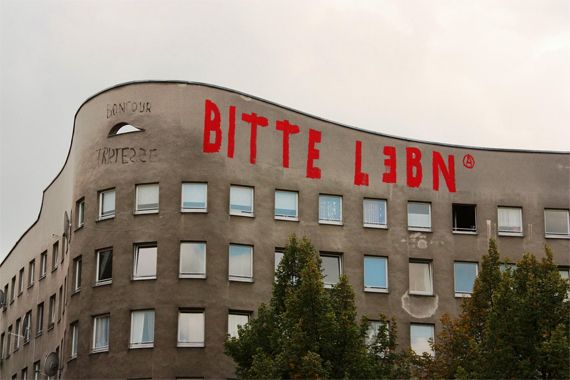
Álvaro Siza, Bonjour Tristesse, Berlin, Germany, 1984.
A graffiti painted on the top of Álvaro Siza’s iconic residential project known as Bonjour Tristesse. The building was part of the Internationale Bauausstellung that took place in 1984, promoting the construction of several new housing projects in the city of Berlin by architects from different parts of the world. Bitte Lebn means Please live. Via 2 Dedos de Conversa.
10 STORIES OF COLLECTIVE HOUSING
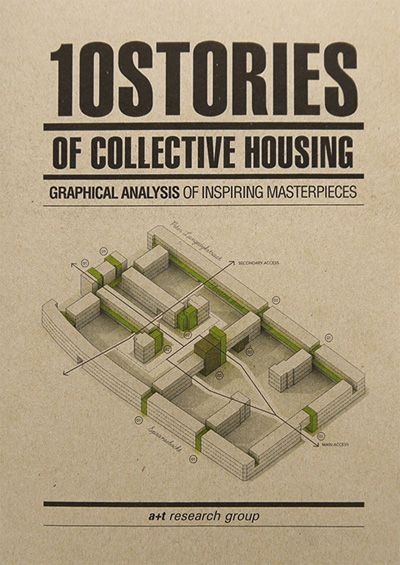
10 STORIES OF COLLECTIVE HOUSING is a new book from a+t architecture publishers. Scroll down to read this text in English.
Uma parte importante da história do modernismo reflecte-se sobre os edifícios de habitação social e colectiva. A popularidade crescente desta corrente de pensamento durante a primeira metade do século vinte e os problemas urbanos prementes que se seguiram à Segunda Guerra Mundial tornaram a arquitectura e o planeamento moderno uma resposta predominante sobre as carências enfrentadas por muitas cidades, particularmente na Europa.
Ainda que a desornamentação, a estandardização e a introdução de processos de construção industrial se tenham revelado aspectos marcantes deste período, verificaram-se muitas abordagens diferentes ao desenho de tipologias comunitárias de habitação. Ideias divergentes de sociedade, de vida moderna e progresso geraram manifestações muito diversas sobre o ambiente construído. Algumas destas construções resistiram ao teste do tempo, algumas mudaram profundamente no decurso de décadas e outras ainda viriam a ser demolidas.
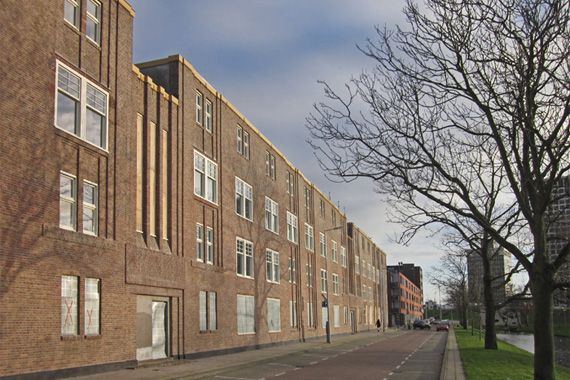
Michiel Brinkman, Justus Van Effen Complex, Rotterdam, The Netherlands, 1919-1922.
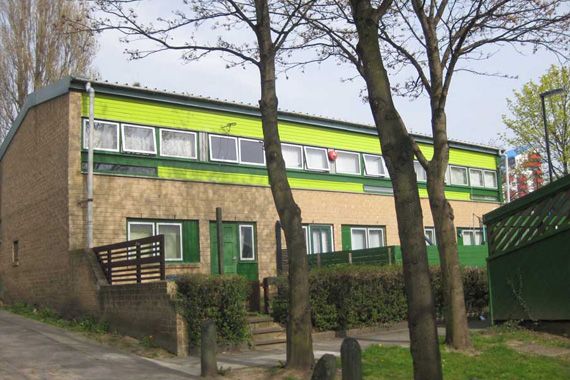
Ralph Erskine, Byker Regeneration, Newcastle-upon-Tyne, United Kingdom, 1969-1982.
10 STORIES OF COLLECTIVE HOUSING conta a história de alguns destes importantes edifícios através da análise das suas características conceptuais e dos traços mais marcantes da vida dos seus autores. O livro apresenta trabalhos de figuras influentes tais como Jean Renaudie, Ralph Erskine, Ignazio Gardella, Fumihiko Maki, Fernand Pouillon, entre outros. Os seus projectos são apresentados e detalhados através de imagens e esquemas gráficos, sendo igualmente relacionados com outros projectos que se lhes seguiram. Esta abordagem original permite ao leitor compreender melhor o impacto destas obras de arquitectura através do tempo e a sua influência sobre projectos contemporâneos.
A ascensão e a queda de alguns destes exemplos de arquitectura habitacional colectiva do modernismo contam-nos a história dos sonhos e das esperanças de uma era motivada pelo optimismo e a ambição, com um sentido de responsabilidade social e o desejo de mudar o mundo. De igual modo, revela-nos o quanto mudámos enquanto sociedade, levantando questões sobre o futuro do ambiente construído e a nossa perda de confiança colectiva no planeamento e no domínio efectivo dos múltiplos processos que conduzem a sua transformação. De uma forma ou de outra, a arquitectura do nosso tempo e o futuro das nossas cidades estará para sempre ligado a estas obras marcantes do passado e à herança de cultura e conhecimento que encontramos nas suas muitas histórias.
Visitem o sítio web da a+t para mais informação sobre este livro e outras publicações .
A significant part of the history of modernism is reflected in collective and social housing buildings. The growing popularity of the architectural movement during the first half of the twentieth century and the pressing urban needs that followed the Second World War made modern architecture and planning a prevalent answer to the urgent problems faced by many cities, particularly in Europe.
Although purity of form, standardization and the introduction of industrialized construction processes were defining aspects of the architectural production of this period, there were many different approaches to the design of communitarian typologies of housing. Diverging ideas about society, modern living and progress generated a distinctive range of manifestations in the built environment. Some of these constructions survived the tests of time, some changed profoundly in the course of decades and others were simply pulled down.
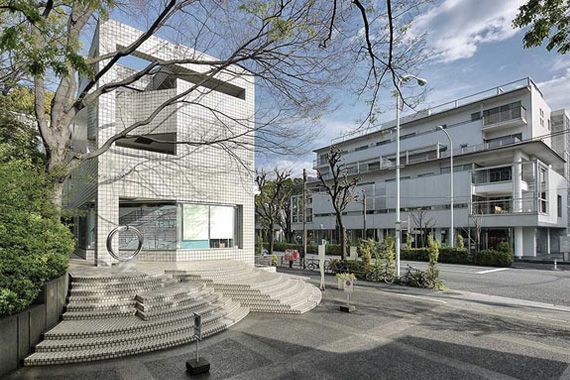
Fumihiko Maki, Hillside Terrace, Tokyo, Japan, 1967-1998.
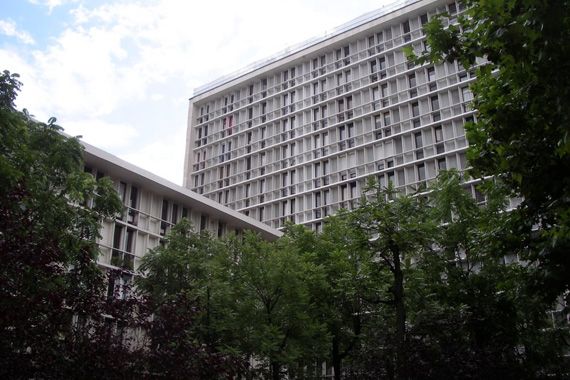
Fernand Pouillon, Résidence du Point du Jour, Paris, France, 1957-1963.
10 STORIES OF COLLECTIVE HOUSING tells the story of some of these important buildings through the elaborate analysis of its conceptual features and the depiction of its authors. The book presents the works of influential figures such as Jean Renaudie, Ralph Erskine, Ignazio Gardella, Fumihiko Maki, Fernand Pouillon, among others. Their projects are not only portrayed through extensive schematic designs but they’re also associated with other works that preceded them. This original approach allows the reader to better comprehend the impact of these architectural masterpieces through time, including in recent 21st century designs.
The ascension and demise of modernist housing buildings tells us the story of the hopes and dreams of an era fueled by optimism and ambition, conducted by a strong sense of social responsibility and the will to change the world for the better. It also tells us how much we have changed as a society, raising questions about the future of our built environment and our collective loss of faith in planning and controlling the multiple processes that guide its transformation. In one way or another, the architecture of our times and the future of our cities is forever linked with the masterpieces of the past and the heritage of culture and knowledge that we can find in their stories.
Visit a+t architecture publishers for additional information on this book and other publications.
What if Peter Zumthor was one of us?

Peter Zumthor is not one of us. Conrad Newel is about to find that out the hard way.
The following post was originally written as a comment on Dear Architecture Journalists: Stop Worshipping Peter Zumthor, published on Architizer by opinions contributor Conrad Newel.
Well, you sir, are just begging for trouble!
This is actually a profoundly relevant topic. As for trying to assertively discuss it on the internet... well... good luck with that!
There is, of course, a problem with the use of the word "architect". Peter Zumthor is an architect. I am an architect. Therefore I could conclude that "I am like Peter Zumthor".
I would be wrong. Just because we use the same words doesn't mean we are talking about the same things. Peter Zumthor openly claims that he is not a service provider. He doesn't work to comply with the promoter's needs or wishes and he is proud of his uncompromising nature.
No, Peter Zumthor is not one of us.
Of course, I'm not going to say that being uncompromising is a virtue or an evil. I will say that it is questionable. I would recommend the documentary "Peter Zumthor - Der Eigensinn des Schonnen" (although it is very difficult to find it nowadays) to witness some of the implications, both good and bad, of that approach to the field of architecture, and how it impacts other people.
The problem with the deification of an architect - or anyone for that matter - is that it narrows down and eventually shuts the possibility of debate. The pernicious aspect of having this cult status being promoted by architectural institutions and media - and when I say media I'm talking about critics that often have ties to official associations and academies - is that it becomes an obstacle to an open and healthy debate about architecture.
The corresponding symptom to that ill environment can be witnessed on these comments already. A possible debate gets shattered, not because the arguments raised are questioned, but because they were replaced by a lawyer type approach where (1) the author's credibility is questioned and, once that is done, (2) any argument presented is deemed irrelevant. A known way of sidestepping any discussion.
Keep in mind that Peter Zumthor's quality as an architect is not being questioned here - although it could, why not? But this is true all around the world. Every nation has its set of highly reverenced architects. If, for watever reason, one of their works becomes controversial, architectural institutions and critics will often close ranks in defense of "the architect", whose personal qualities or overall body of work are not being questioned, to minimize the debate around "the building".
That is why you will have great difficulty finding architects openly questioning buildings such as Calatrava's City of Arts and Sciences, Peter Eisenman's City of Culture of Galicia, Zaha Hadid's Zaragoza Bridge Pavilion, and so on, and so on. And if you are an architect and you question these buildings, trust me, doors will shut on you, and you will be on your way to become an outcast.
The real issue here, therefore, is that the glorification of architects is detrimental to a democratic environment where ideas, including architecture, can be questioned through rational considerations from which we can all learn and evolve.
And if we deny that, if we deny the possibility of that to happen because whoever is pointing the finger doesn't hold the seal of some ubber-institution, then we all run the risk of becoming a silent witness among the crowd, paying tribute to naked kings.
The problem with architects
If you like fantasy and you want to be the next Tolkien, don’t read big Tolkienesque fantasies – Tolkien didn’t read big Tolkienesque fantasies, he read books on Finnish philology. Go and read outside of your comfort zone, go and learn stuff.
— Neil Gaiman, Nerdist podcast, 2011. Via Brain Pickings.
The problem with architects is that they care too much about architecture. We spend way too much time and energy talking about architecture, reading architecture books and magazines, visiting architecture blogs and websites, nurturing a monocultural viewpoint on the world that surrounds us.
Architecture is a field of knowledge that spreads into many different areas of life. It’s not just about material buildings, it’s not just about light or about the art of drawing or whatever fantasy you’ve been told in college. It’s about the interaction of things in the inhabited world.
The most difficult thing in creating good architecture or urban design is that there’s a lot of complexity going on, there are too many layers. Everytime you look at things from a different point of view you see different things. If you’re considering structure, for example, thinking about the right balance between material resources and the needs of the building, you will assess a number of interrogations. But if you’re thinking about daylight or rain, about the air flow, about electricity and a myriad infrastructures, about garbage disposal or sewage draining, you will see other things.
And if you widen that thought process to areas like, say, energy consumption or sociology, or economy, or history, you will see even more things you didn’t consider in the first place.
So when some architect says that projects are “born” on a napkin drawing, what can you say? Can you put that amount of thought in a sketch made over a cup of coffee? Do you think a good work of architecture is born from a moment of inspiration? Well, I don’t.
These thoughts came to me as I was watching S G Collins, director of Postwar Media, talking in his latest video, Return to Civilization.
Now, here’s the thing. I’m not saying I agree with everything he’s saying – although I can’t help identifying with his tongue-in-cheek sense of humour. But that’s not really the point. No, the most interesting thing is that here is a non-architect talking about architectural issues, and doing so by presenting different questions. By addressing the multi-layered complexity of architecture and urbanism that is often missing in the monocultural discourse architects tend to surround their profession with.
The problem with architects is that we need to change the way we question, think and execute our work. We need to go outside of our comfort zone. Monocultural thinking is our greatest enemy.
Facebook as a formative aesthetic experience

Over one billion people stare at the same screen everyday, but what does it mean? Scroll down to read this text in English.
Mais de mil milhões de utilizadores passam tempo no Facebook, todos os dias. Isto significa que todas estas pessoas contemplam e interagem com o mesmo interface gráfico, repetidamente, por todo o mundo. Esta realidade esmagadora – o facto de um tão vasto e diverso universo de pessoas partilhar a mesma plataforma – traz consigo diversas consequências.
Gostem ou não, o “template” do Facebook é uma parte da vossa vida. É um ecossistema cultural que condiciona a vossa experiência “social” na internet através do design gráfico e do seu conjunto de funcionalidades. Tal como um condutor experiente não precisa de “pensar” sobre o acto de conduzir um automóvel, também já não perdemos tempo a pensar em como se fazem as coisas no Facebook. Simplesmente “fazemo-lo”. Para o Facebook, isto implica que quaisquer modificações têm de ser introduzidas de forma prudente.
Em todas as vezes que o Facebook sofreu alterações, os utilizadores queixaram-se. Quando se trata de grandes plataformas online, a mudança é sempre indesejada. Os utilizadores odeiam o inesperado e fazem ouvir a sua voz quando ele acontece: Para onde foi aquele botão?
Para grandes corporações como o Facebook, esta sociologia complexa impõe restrições à sua evolução. As mudanças têm de encaixar no mais largo denominador comum. Elas têm de ser acessíveis e compreensíveis por todos, dos adolescentes aos idosos, daqueles que cresceram com os computadores a pessoas que só utilizaram a internet para estar no… Facebook. E é por isso que coisas assim não podem acontecer.
No que respeita ao avanço da cultura web contemporânea, este é um problema com implicações sérias. As massas da internet tornaram-se conservadoras. Elas não gostam e não desejam o “novo”. Em oposição ao que aconteceu na era dourada dos blogs, quando estes eram desenhados e celebrados em todos os formatos e cores, esta nova paisagem da internet é estática e constrangida. Tende para a não evolução, não devido a limitações técnicas, mas porque estas plataformas têm medo de alienar a sua vasta base de utilizadores.
Over one billion active users spend time on Facebook, every single day. If you think about it, that means that all these people are persistently staring and interacting with the same graphic user interface, all over the world. This overwhelming reality – the fact that such a wide and diverse population shares the same platform – has many implications.
Wether you like it or not, the Facebook template is a part of your life. It’s a cultural environment that conditions your social experience through its design and its particular set of functionalities. Just as an experienced driver doesn’t need to “think” about driving, you don’t need to worry about how to do things on Facebook anymore. You just “do it”. For Facebook, it means that it can’t change its features lightly.
Every single time Facebook introduced changes to its user interface, people complained. When it comes to popular internet platforms, change is always unwelcome. Users hate the unexpected and they will become vocal about it: Where did this button go?
For huge companies like Facebook, this complex sociology imposes severe restrictions to evolution. Changes must fit the highest common denominator. They must be accessible and understandable by all, from teenagers to senior citizens, from people who grew up interacting with computers to people who have only used the internet to be on… Facebook. That’s why things like this can’t happen.
When it comes to the advancement of contemporary web design culture this presents a problem with serious implications. The internet masses have become fiercely conservative. They don’t like and they don’t desire the “new”. In opposition to what happened in the golden age of blogging, when blogs where being designed and celebrated in all shapes and colors, this new internet landscape is static and constricted. It’s not evolving, not for technical limitations, but because these platforms are afraid of alienating their wide user base. Fear is in the lead and all the big players are treading lightly.
Last House Standing
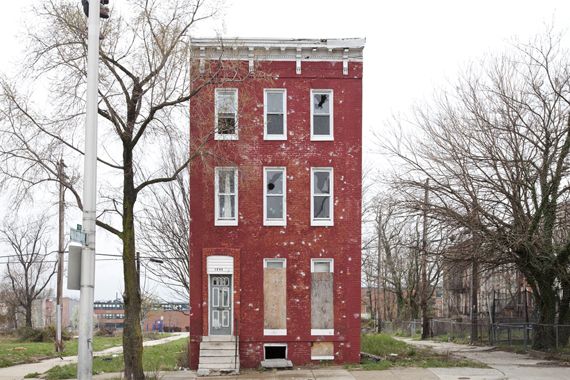
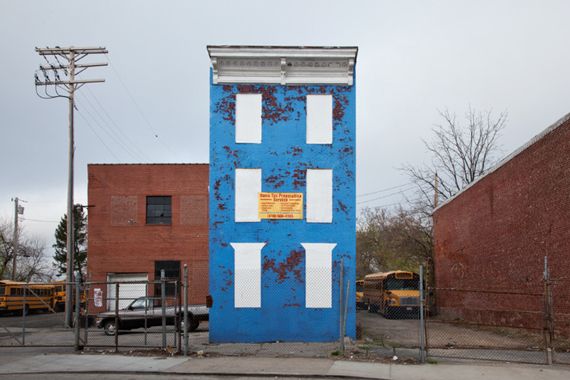
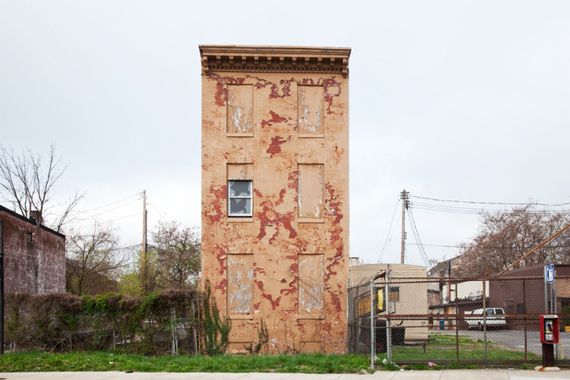
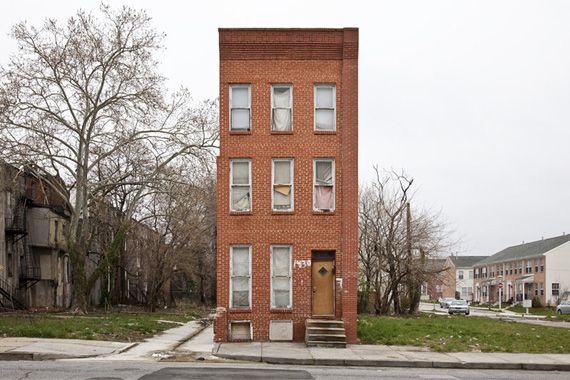
Last House Standing is a photographic essay by Ben Marcin.
As casas também resistem. Ben Marcin, fotógrafo americano de origem germânica, registou imagens de casas “em banda” que hoje permanecem isoladas. O autor faz notar que, em muitos casos, estas últimas habitações se encontram ocupadas. Falam-nos, mais do que sobre elas mesmas, de como a vida pode persistir à disfunção da cidade que as rodeia. Via Sound + Vision, Feature Shoot.
Bilhete postal

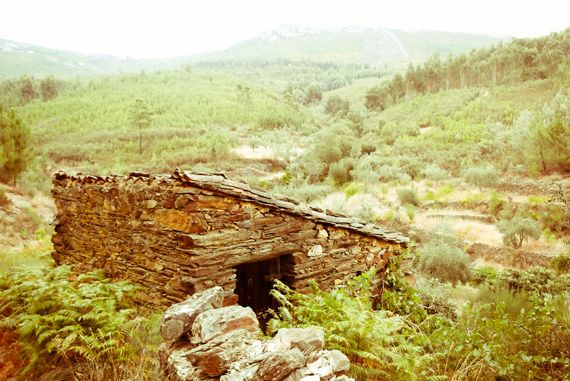



A história dos incêndios também se conta nas casas devolutas, nas hortas abandonadas, nos abrigos fechados do pasto e dos animais, nas ruínas dos moinhos de água. A culpa, votaram na televisão, é dos donos dos terrenos que não limpam as florestas. Onde estão eles? Não passaram tantas décadas assim. Por aí andavam percorrendo esses montes, por trilhos hoje invadidos de silvas, recolhendo os restos da mata a que hoje, lá longe da cidade, chamamos de resíduos. Para aquecer as habitações nas noites frias, cozinhar os alimentos, fazer as camas dos animais que depois serviriam de adubo aos solos de cultivo. O que mudou, então, foi todo um modo de nos relacionarmos com o território. Esta gente não existe mais e aqueles gestos não teriam hoje qualquer sentido. O problema dos incêndios é assim, em grande medida, o problema da nossa relação com o mundo.
Subscrever:
Comentários (Atom)
![[a barriga de um arquitecto]](https://blogger.googleusercontent.com/img/b/R29vZ2xl/AVvXsEh4jxSFgS7aN5np9gNAv5D6FLs8GihH_1lu1XrTdi7CmZ6DwtdH1DQ7u6RQnN6SosH_HFrY3YQzoLlvzBeEK-cxh0dveIqPEsEC661K_iPUh0NifbNNN-mRoy6nVc0ycEi972Llyg/s1600/bA_LOGO_MOCHA_2016_650.jpg)